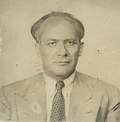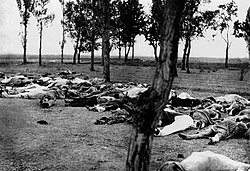Genocide

Genocide is the crime of trying to destroy an ethnic, racial, national or religious group. Genocides are done by killing and harming the group, preventing them from being able to live (like starving them), or by assimilating them, stopping them from having kids and destroying their identity.
Genocide is usually done by governments and large armies or paramilitaries. Genocide is often motivated by hatred or fear of the group, and for political reasons.
The word genocide was made up by Raphael Lemkin, a Polish Jew, in 1944, from the words "genos" (Greek for family, tribe or race) and "-cide" (from the Latin "occidere", to kill). It was first used to the Nazi Holocaust, when many groups, including Jews and others, were killed.
Ustashe of Croatia are another example of genocidial horror. About a million of Serbs were killed during WWII in Ustashe death camps especially in Jasenovac. Another example of genocide was when about a million of the Tutsi group of people of Rwanda were killed along with Hutus who were against the genocide in 1994.
In 1933 Lemkin made a speech to the Legal Council of the League of Nations conference on international criminal law in Madrid, for which he prepared an essay on the Crime of Barbarity as a crime against international law. The purpose of the crime, which later evolved into the idea of genocide, was based mostly on the experience of Assyrians[1] massacred in Iraq on 11 August 1933. The event in Iraq reminded him of earlier similar events of the Armenian Genocide during World War I.[1]
Today, any genocide is prohibited by the Genocide Convention and actor or inciter of genocide is judged by the International Criminal Court.
Examples
Today most people see the following events as genocide. Note that the events listed are just examples.
Genocide Media
Raphael Lemkin coined the term genocide in 1944. His analysis of Nazi atrocities inflicted on the Poles were adopted by the UN Genocide Convention as its criteria for determining "genocidal intent"
Aftermath of the 1941 Odessa massacre, in which Jewish deportees were killed outside Brizula (now Podilsk) during the Holocaust
Members of the Sonderkommando burn corpses of Jews in pits at Auschwitz II-Birkenau, an extermination camp.
As part of the Native American genocide, the U.S. federal government promoted bison hunting for various reasons, including as a way of destroying the means of survival of Plains Indians to pressure them to remain on Indian reservations.
Human skulls at the Murambi Genocide Memorial Centre in Rwanda
Armenian genocide victims
Nuon Chea, the Khmer Rouge's chief ideologist, before the Cambodian Genocide Tribunal on 5 December 2011
The Nazi leaders at the Palace of Justice, Nuremberg
The cemetery at the Srebrenica-Potočari Memorial and Cemetery to Genocide Victims
- Photographs of Genocide Victims - Genocide Memorial Center - Kigali - Rwanda.jpg
Photographs of Rwandan genocide victims displayed at the Genocide Memorial Center in Kigali
References
- ↑ 1.0 1.1 Raphael Lemkin - EuropeWorld, 22/6/2001









